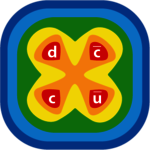Hadrons are particles which interact via the strong force. Unlike leptons, e. g. the electrons, they are not elementary but consist of the elementary quarks and anti-quarks. Two types of hadrons have been discovered up to now in manifold variations: Baryons, which are consisting of three quarks, and mesons, which are bound states of a quark and an anti-quark. The most common baryons are protons and neutron, the building blocks of all atomic nuclei. In the recent past, there is evidence that also hadrons with more than 3 quarks exist and are called tetraquarks (4) and pentaquarks (5).
The detection of the Zc(3900)± with a minimum of 4 constiuent quarks in 2013 was one of the greatest discoveries in this decade and the top highlight of this year in physics (source APS).
The PANDA Experiment is the main task of GSI hadron physics and the ultimate work horse for the future of hadron physics world-wide. It uses a versatile detector and will be one of the key experiments at the Facility for Antiproton and Ion Research (FAIR) which is under construction and currently being built on the area of the GSI Helmholtzzentrum für Schwerionenforschung in Darmstadt, Germany. Antiprotons produced by a primary proton beam will then be filled into the High Energy Storage Ring (HESR) which collide with the fixed proton or nuclear target inside the PANDA detector to investigate the structure and dynamics of hadrons.
The PANDA detector is under construction in institutes all over the world under the with the technical coordination by PANDA at GSI and FAIR. GSI is broadly involved into many aspects of PANDA.
The BES III Experiment at the BEPC-2 electron-positron collider at IHEP in Beijing (China) uses colission energies from 3.5 GeV to 4.7 GeV for the spectrsocopy and the investigation of the structure of light and heavy hadrons and is in operation since 2008 with a impressive record of important results, like the Zc(3900)± and the X0(1835).
The emphasis of the GSI group in BES III is the search for more XYZ states and the determination of the static and dynamical properties, like spin-parity and decays.
The GlueX-Experiment in Hall-D at CEBAF at Jefferson National Lab (USA) facilitates a (polarized) photon-beam of up to 12 GeV to produce normal and exotic hadrons of a proton or nuclear target. It is part for the JLab12 upgrade being finished recently and is ready for regular operation.
The emphasis of the GSI group in GlueX is the development of the GlueX-DIRC together with MIT, JLab, and Indiana University and the search for exotic strangeonium systems and the determination of their static and dynamical properties, like spin-parity and decays.







